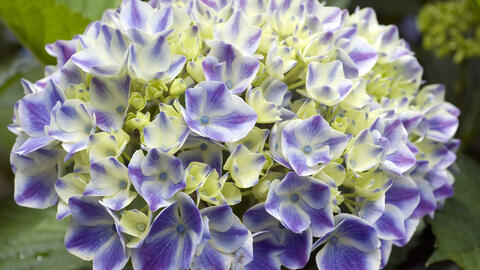Successfully overwintering the Hydrangeas
Be it in the pot or outdoors: Some Hydrangeas need good winter protection to survive the cold season. This is how you protect these flowering shrubs in the winter months.

Blue Hydrangea bouquet
Hydrangeas can be planted both in the container as well as the flower bed — however, some species require winter protection in both cases, at least in cold regions, or should be protected from frost in the winter months. This applies especially to the newer varieties of Mophead Hydrangea, Garden Hydrangea (Hydrangea macrophylla) and the Tea of Heaven, Mountain Hydrangea (Hydrangea serrata).
Mophead Hydrangea and Tea of Heaven are nowadays mostly grown in containers and as houseplants - therefore winter hardiness is no longer one of the primary breeding goals. As they are sub-shurbs, even the old garden varieties are not reliably hardy everywhere. That is, the shoots of the current year become woody only at the base and the shoot tips with flowers freeze in the cold winters. Winter protection outdoors is particularly recommended in regions with cold winters. Although it isn’t so cold that the sub-shrub freezes completely, a few nights with temperatures below -4 degrees and cold east winds are often enough to destroy the blooms for the next season.
If you plant your Hydrangeas as container plants, it can survive the winters with suitable winter protection in a covered place in the open. First wrap the planter with several layers of insulating bubble wrap and then wrap it in a thick coconut mat. Then tie the mat with a cord. Ensure that it protrudes about 3.93 inches beyond the edge of the pot and then cover the surface of the root ball with fall leaves. Place the Hydrangea, as mentioned above, in a covered, wind and rain-protected place on the house wall. If the pot is on a paved surface here, it also needs insulation from below. You can put it on a styrofoam plate or on a thick wooden board.

Note that the Hydrangeas need to be watered occasionally in the rain-sheltered places, so that the roots do not dry out. Most of the modern varieties of these flowering shrubs are not affected if the portion above ground freezes. They grow out well from the base and new shoot buds sprout in the same year, so you need not miss its splendor.
If you live in a very cold winter region, it is better to keep your potted Hydrangeas indoors during winters. The ideal winter shelter is a cold greenhouse, that is, an unheated greenhouse. It should be well protected against the winter sun so that the temperature fluctuations are not too high. Overwintering in the dark is also possible, however, the temperatures should not go above 41 degree Fahrenheit, otherwise the metabolism of the Hydrangeas slows down considerably. A bright, warm hibernation is also possible, but not optimal - experience shows that the shrubs are easily attacked by scale insects. Also, no dormant period means the formation of new flower buds is inhibited.
Pruning of the frozen or dead old flower shoots should be done only in spring when heavy frosts are over. Repeat flowering varieties can be shortened like perennials to about a handbreadth above the ground.
In regions with mild winters, older Hydrangreas planted out in the garden usually do not need winter protection - as long as they have a species-appropriate location in semi-shade on humus-rich soil. In the continental climate, you should mulch the shrubs in fall with a thick layer of leaves covered with pine twigs. In addition, you can temporarily cover the crowns with winter fleece if there are persistent and severe frosts. Older varieties of the Mophead Hydrangeas and Tea of Heaven do not rebloom, which is why the flowers often fail for a year after severe frost damage. Winter protection is generally recommended for newly planted Hydrangeas that have not yet experienced winters in outdoors.
Panicle Hydrangeas (Hydrangea paniculata) and Smooth Hydrangeas (Hydrangea arborescens) are the most frost-hardy. They do not need any winter protection. Since these species only create their flower buds on the newly formed shoots, the old flower shoots are cut back heavily in the spring and frost damage, if any, is also removed.





